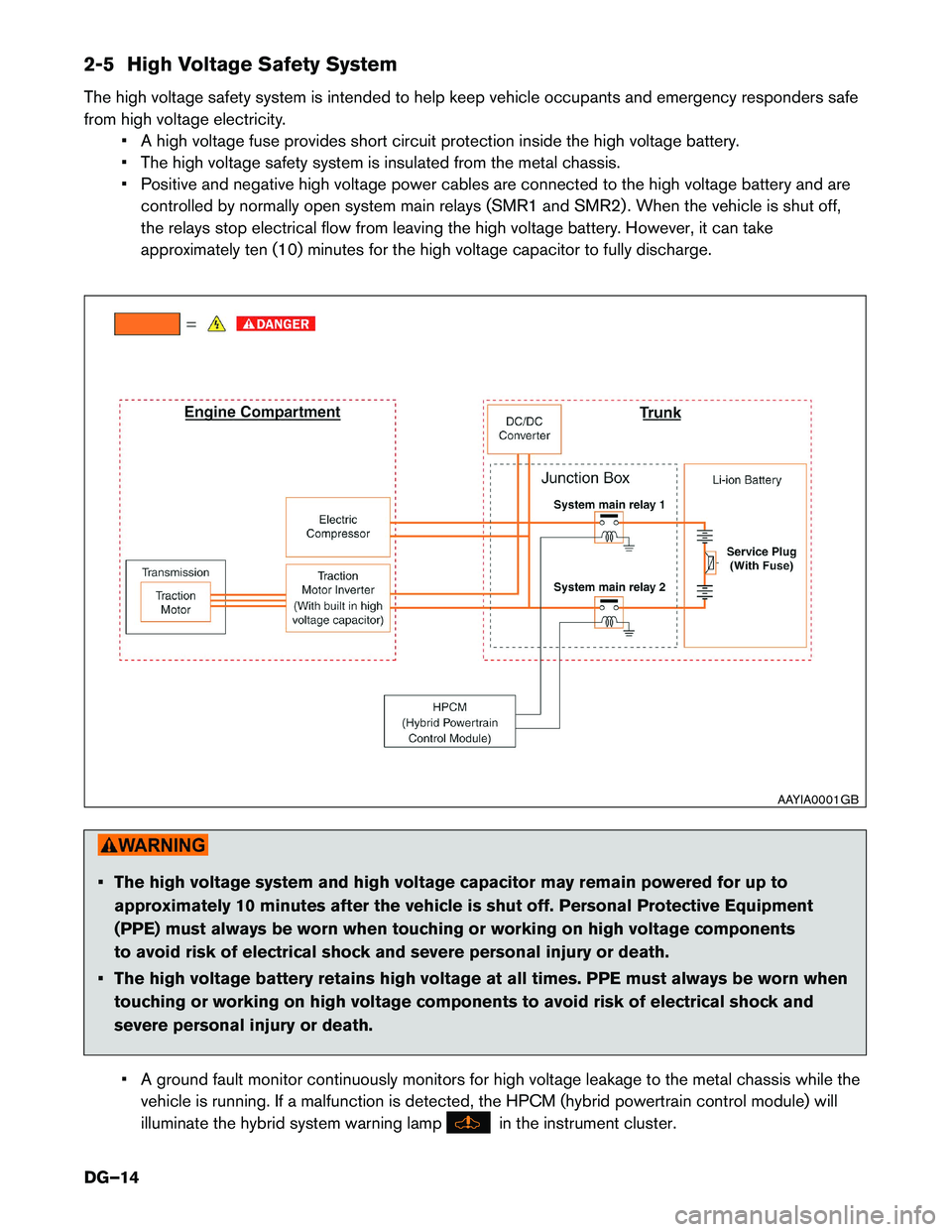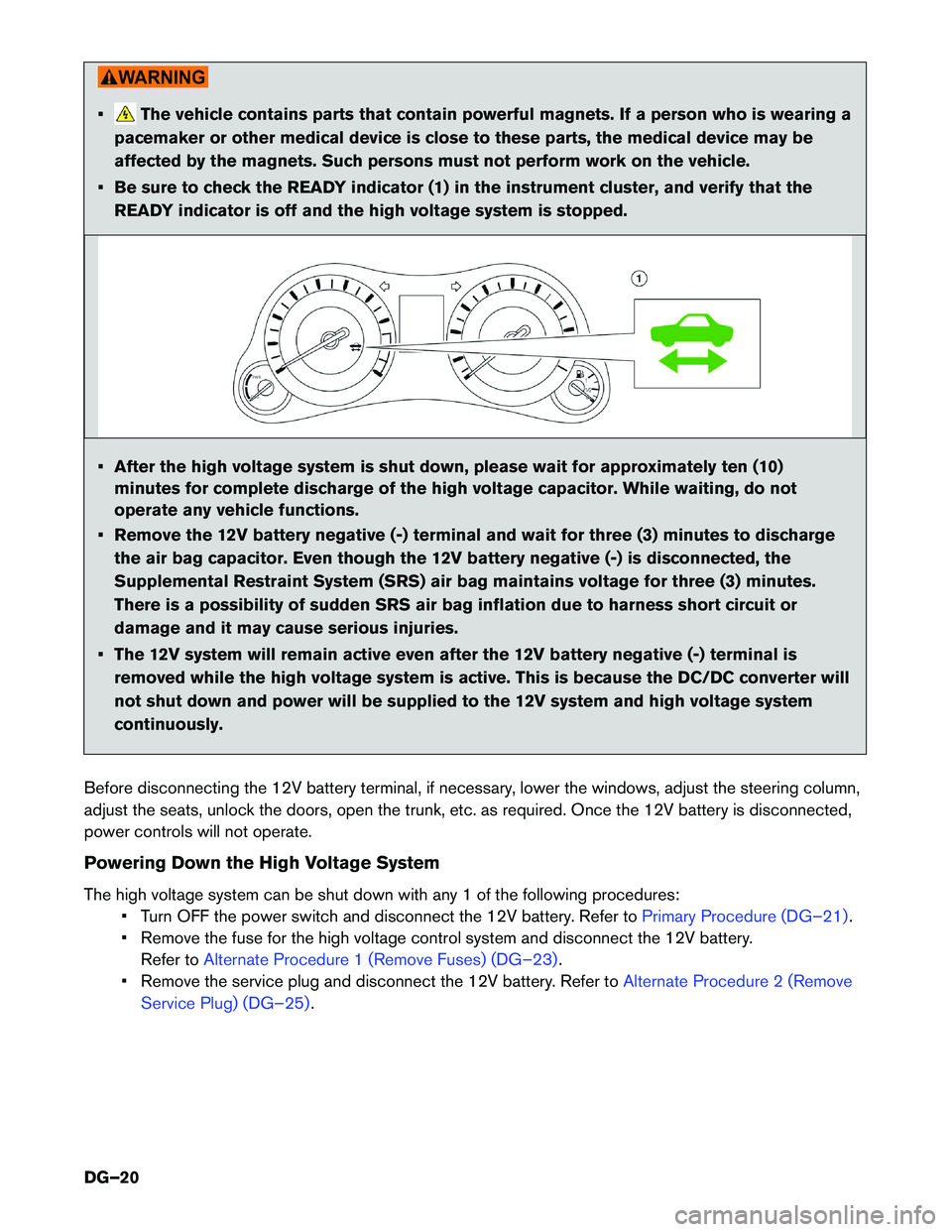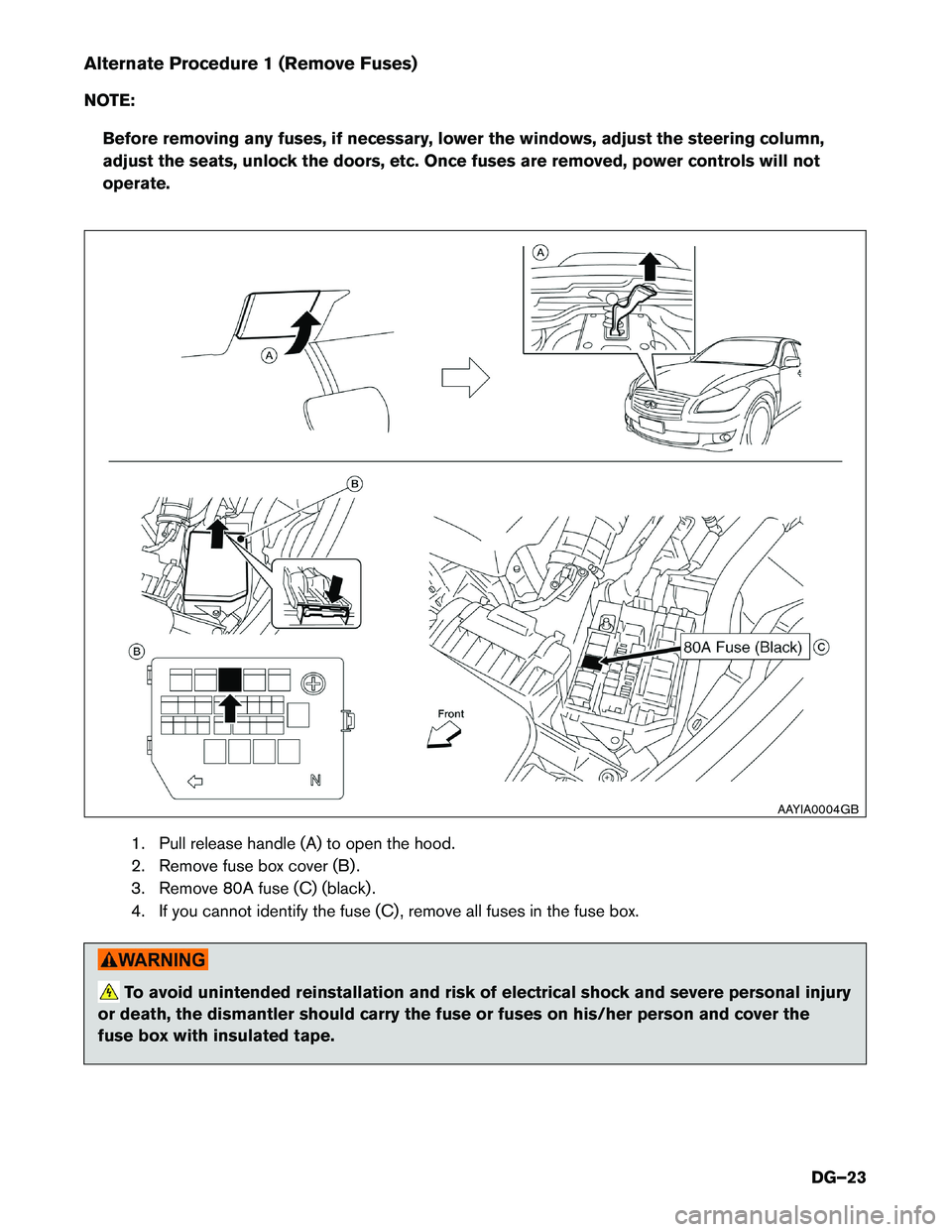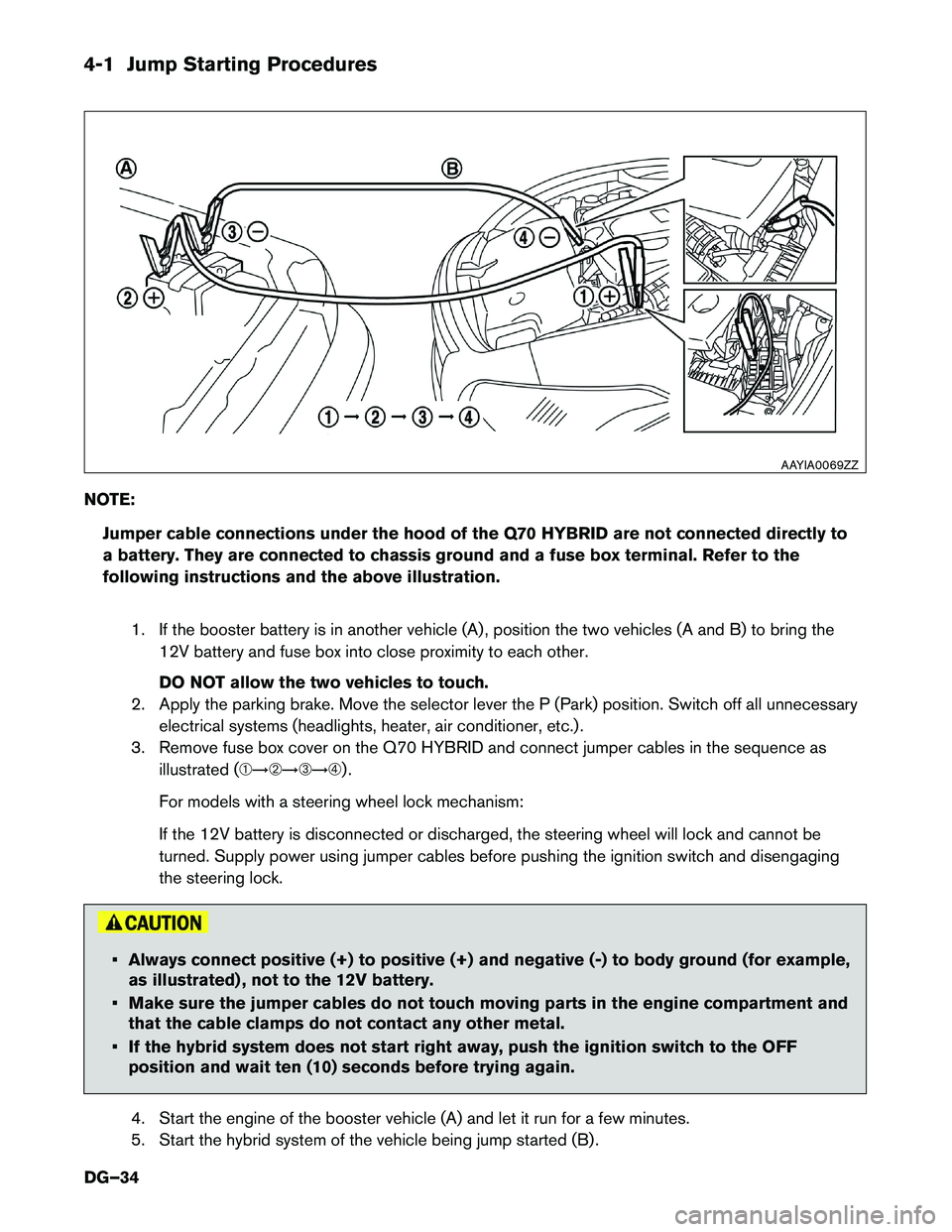fuse INFINITI Q70 HYBRID 2014 Dismantling Guide
[x] Cancel search | Manufacturer: INFINITI, Model Year: 2014, Model line: Q70 HYBRID, Model: INFINITI Q70 HYBRID 2014Pages: 51, PDF Size: 3.65 MB
Page 14 of 51

2-5 High Voltage Safety System
The
high voltage safety system is intended to help keep vehicle occupants and emergency responders safe
from high voltage electricity. • A high voltage fuse provides short circuit protection inside the high voltage battery.
• The high voltage safety system is insulated from the metal chassis.
• Positive and negative high voltage power cables are connected to the high voltage battery and arecontrolled by normally open system main relays (SMR1 and SMR2) . When the vehicle is shut off,
the relays stop electrical flow from leaving the high voltage battery. However, it can take
approximately ten (10) minutes for the high voltage capacitor to fully discharge. • The high voltage system and high voltage capacitor may remain powered for up to
approximately
10 minutes after the vehicle is shut off. Personal Protective Equipment
(PPE) must always be worn when touching or working on high voltage components
to avoid risk of electrical shock and severe personal injury or death.
• The high voltage battery retains high voltage at all times. PPE must always be worn when touching or working on high voltage components to avoid risk of electrical shock and
severe personal injury or death.
• A ground fault monitor continuously monitors for high voltage leakage to the metal chassis while the vehicle is running. If a malfunction is detected, the HPCM (hybrid powertrain control module) will
illuminate the hybrid system warning lamp in the instrument cluster. AAYIA0001GB
DG–14
Page 20 of 51

• The vehicle contains parts that contain powerful magnets. If a person who is wearing a
pacemaker or other medical device is close to these parts, the medical device may be
affected by the magnets. Such persons must not perform work on the vehicle.
• Be sure to check the READY indicator (1) in the instrument cluster, and verify that the READY indicator is off and the high voltage system is stopped.
• After the high voltage system is shut down, please wait for approximately ten (10) minutes for complete discharge of the high voltage capacitor. While waiting, do not
operate any vehicle functions.
• Remove the 12V battery negative (-) terminal and wait for three (3) minutes to discharge the air bag capacitor. Even though the 12V battery negative (-) is disconnected, the
Supplemental Restraint System (SRS) air bag maintains voltage for three (3) minutes.
There is a possibility of sudden SRS air bag inflation due to harness short circuit or
damage and it may cause serious injuries.
• The 12V system will remain active even after the 12V battery negative (-) terminal is removed while the high voltage system is active. This is because the DC/DC converter will
not shut down and power will be supplied to the 12V system and high voltage system
continuously.
Before disconnecting the 12V battery terminal, if necessary, lower the windows, adjust the steering column,
adjust the seats, unlock the doors, open the trunk, etc. as required. Once the 12V battery is disconnected,
power controls will not operate.
Powering Down the High Voltage System
The high voltage system can be shut down with any 1 of the following procedures: • Turn OFF the power switch and disconnect the 12V battery. Refer to Primary Procedure (DG–21)
.
•
Remove the fuse for the high voltage control system and disconnect the 12V battery.
Refer to Alternate Procedure 1 (Remove Fuses) (DG–23) .
•
Remove the service plug and disconnect the 12V battery. Refer to Alternate Procedure 2 (Remove
Service
Plug) (DG–25) .DG–20
Page 23 of 51

Alternate Procedure 1 (Remove Fuses)
NO
TE:
Before removing any fuses, if necessary, lower the windows, adjust the steering column,
adjust the seats, unlock the doors, etc. Once fuses are removed, power controls will not
operate.
1. Pull release handle (A) to open the hood.
2. Remove fuse box cover (B) .
3. Remove 80A fuse (C) (black) .
4. If you cannot identify the fuse (C) , remove all fuses in the fuse box. To avoid unintended reinstallation and risk of electrical shock and severe personal injury
or
death, the dismantler should carry the fuse or fuses on his/her person and cover the
fuse box with insulated tape. AAYIA0004GB
DG–23
Page 24 of 51

5. Open the trunk. The trunk can be opened with the push-button switch (D) on the lower LH side of
the instrument panel or with the mechanical key (E) housed inside the Infiniti Intelligent Key.
6. Open the 12V battery service access cover (F) .
7. Disconnect negative (-) battery cable (G) and cover it with insulated tape.
8. Wait approximately ten (10) minutes for complete discharge of the high voltage capacitor after the fuse is pulled and battery cable has been disconnected.
9. Perform the dismantling operation. Refer to 6. Dismantling Information (DG–38). AAYIA0011GB
DG–24
Page 28 of 51

11. Wait approximately ten (10) minutes for complete discharge of the high voltage capacitor after
the service plug has been removed.
12. Perform the dismantling operation. Refer to 6. Dismantling Information (DG–38).
3-4.2
Cutting the Vehicle Body • Do not cut into high voltage related areas to avoid severe personal injury or death.
• Do not cut into the Li-ion battery to avoid severe personal injury or death.
• When removing parts, NEVER touch the high voltage parts or the insides of the
exposed
orange-colored high voltage cables to avoid severe personal injury or death.
Personal Protective Equipment (PPE) must always be worn when touching or
working on high voltage components. To avoid unintended reinstallation and risk of electrical shock and severe personal injury or
death,
the dismantler should carry the fuses or service plug on his/her person while work
is in progress. Do not cut air bag parts to avoid unintended deployment of the air bags and the risk of
severe
personal injury or death.
If approximately ten (10) minutes have passed since the rescuer shut down the high voltage system (refer to
3-4.1 High Voltage System Shut-Down Procedure (DG–19)) , then the dismantler can cut the vehicle
except
for the Li-ion battery. DO NOT cut the Li-ion battery due to possible electrocution risk and electrolyte solution
leakage.
DG–28
Page 34 of 51

4-1 Jump Starting Procedures
NO
TE:
Jumper cable connections under the hood of the Q70 HYBRID are not connected directly to
a battery. They are connected to chassis ground and a fuse box terminal. Refer to the
following instructions and the above illustration.
1. If the booster battery is in another vehicle (A) , position the two vehicles (A and B) to bring the12V battery and fuse box into close proximity to each other.
DO NOT allow the two vehicles to touch.
2. Apply the parking brake. Move the selector lever the P (Park) position. Switch off all unnecessary electrical systems (headlights, heater, air conditioner, etc.) .
3. Remove fuse box cover on the Q70 HYBRID and connect jumper cables in the sequence as illustrated (�������) .
For models with a steering wheel lock mechanism:
If the 12V battery is disconnected or discharged, the steering wheel will lock and cannot be
turned. Supply power using jumper cables before pushing the ignition switch and disengaging
the steering lock. • Always connect positive (+) to positive (+) and negative (-) to body ground (for example,
as
illustrated) , not to the 12V battery.
• Make sure the jumper cables do not touch moving parts in the engine compartment and that the cable clamps do not contact any other metal.
• If the hybrid system does not start right away, push the ignition switch to the OFF position and wait ten (10) seconds before trying again.
4. Start the engine of the booster vehicle (A) and let it run for a few minutes.
5. Start the hybrid system of the vehicle being jump started (B) . AAYIA0069ZZ
DG–34
Page 35 of 51

6. After starting the hybrid system, carefully disconnect the negative cable and then the positive
cable (�������) .
7. Reinstall the fuse box cover.
NOTE:
If it is not possible to turn the hybrid system ON by following this procedure, contact
an INFINITI retailer immediately.
4-2 Shift Selector Lever Lock Release
If the 12V battery is low or discharged, the selector lever cannot be moved from the Park (P) position. If a booster bat-
tery is not available, the selector lever lock can be manually released. To manually release the selector lever lock, perform
the following procedure: 1. Push the ignition switch to the LOCK or OFF position.
2. Apply the parking brake.
3. Remove the shift lock cover (A) using a suitable tool.
4. Push down the shift lock (B) as shown in the illustration.
5. Push the selector lever button (C) and move the selectorlever to the Neutral (N) position (D) while holding down
the shift lock. AAYIA0067ZZ
DG–35
Page 44 of 51

16. Remove the mounting nut (A) and then disconnect the
harness from the fuse box on the left side of the trunk
room.
17. Disconnect the brake power supply backup unit harness connector (A) and remove the ground cable mounting
bolts (B) . : Vehicle front
18.
Disconnect the high voltage harness connector (A) and
harness connector (B) . : Vehicle front
Touching high voltage components without wearing
appropriate
Personal Protective Equipment (PPE) will
cause electrocution. Immediately protect the terminals of the disconnected
high
voltage harness connector socket using insulated
tape so that they are not exposed.
19. Disconnect the Li-ion battery cooling fan motor harness connector. JSCIA0279ZZ
JSCIA0280ZZ
JSCIA0281ZZ
AAYIA0043ZZ
DG–44